Analysis and Visualization of Research on Resilient Cities and Communities Based on VOSviewer
Abstract
:1. Introduction
2. Materials and Methods
3. Results
3.1. The Growth and Output Publications
3.2. Source Distribution of Publications
3.3. Collaboration Networks
3.4. Citation and Co-Citation Analysis
3.5. Keyword Hotness Analysis
4. Conclusions
- (1)
- The development process is roughly divided into 3 periods: no attention (1995–2004), starting (2005–2014), and rapid growth (2015–2021). After 2014, the research documents in this field showed a steady increase. Generally, a variety of RC studies have attracted an increasing concern in recent years;
- (2)
- The journal “Sustainability” and “International journal of disaster risk reduction” are the key journals which have published resilient cities or communities research;
- (3)
- The USA, Canada, and Australia are the countries dominating the publication production. Colorado State Univ, Texas a&m Univ, and Delft Univ Technol have the most documents in RC research publishing 14 papers. A total of 8 of the top-17 institutions are located in the USA. The USA is still the leading country in this field of RC. Serre and Shaw are the most productive authors. Results indicate that many scholars still publish independently and have less contact with other teams;
- (4)
- The most cited paper is from Adger (2000) titled “Social and ecological resilience: are they related?”, Holling (1973): Resilience and Stability of Ecological Systems has the highest total link strength. A quick overview of the research in this field can be obtained from literature;
- (5)
- A keyword analysis indicates that most of the research before 2014 focused on adaptation, vulnerability, management, resilient cities, climate change, disaster, and sustainability. In the most recent years, the notable research topics concentrated on the climate-change, framework, and urban resilience.
Author Contributions
Funding
Institutional Review Board Statement
Informed Consent Statement
Data Availability Statement
Conflicts of Interest
References
- Holling, C.S. Resilience and stability of Ecological Systems. Annu. Rev. Ecol. Syst. 1973, 4, 1–23. [Google Scholar] [CrossRef] [Green Version]
- Walker, B.; Salt, D.; Chen, B.M. Resilience Thinking: Sustaining Ecosystems and People in a Changing World; Higher Education Press: Beijing, China, 2010. [Google Scholar]
- Pawar, B.; Park, S.; Hu, P. Applications of resilience engineering principles in different fields with a focus on industrial systems: A literature review. J. Loss Prev. Process Ind. 2020, 69, 104–366. [Google Scholar] [CrossRef]
- Hayes, S.; Desha, C.; Burke, M. Leveraging socio-ecological resilience theory to build climate resilience in transport infrastructure. Transp. Rev. 2019, 1, 1–23. [Google Scholar] [CrossRef]
- Alan Bond, A.B.; Angus Morrison-Saunders, B.C.; Jill, A.E. Managing uncertainty, ambiguity and ignorance in impact assessment by embedding evolutionary resilience, participatory modelling and adaptive management. J. Environ. Manag. 2015, 151, 97–104. [Google Scholar] [CrossRef] [Green Version]
- Shao, Y.W.; Xu, J. Understanding Urban Resilience: A Conceptual Analysis Based on Integrated International Literature Review. Urban Plan. Int. 2015, 30, 48–54. [Google Scholar]
- Gunderson, L.H. Ecological resilience-in theory and application. Annu. Rev. Ecol. Syst. 2000, 31, 425–439. [Google Scholar] [CrossRef] [Green Version]
- Pickett, S.T.; McGrath, B.; Cadenasso, M.L.; Felson, A.J. Ecological resilience and resilient cities. Build. Res. Inf. 2014, 42, 143–157. [Google Scholar] [CrossRef]
- Jennings, B.J.; Vugrin, E.D.; Belasich, D.K. Resilience certification for commercial buildings: A study of stakeholder perspectives. Environ. Syst. Decis. 2013, 33, 184–194. [Google Scholar] [CrossRef]
- Fletcher, D.; Sarkar, M. Psychological resilience. Eur. Psychol. 2013, 18, 12–23. [Google Scholar] [CrossRef] [Green Version]
- Lee, A.V.; Vargo, J.; Seville, E. Developing a tool to measure and compare organizations’ resilience. Nat. Hazards Rev. 2013, 14, 29–41. [Google Scholar] [CrossRef]
- Mcglade, J.; Murray, R.; Baldwin, J.S.; Ridgway, K.; Winder, B. Industrial Resilience and Decline: A Co-Evolutionary Framework; Edward Elgar: Picton, ON, Canada, 2006; pp. 47–176. [Google Scholar]
- Wildavsky, A.B. Searching for Safety; Transaction Publishers: Piscataway, NJ, USA, 1988. [Google Scholar]
- Barnett, J. Adapting to Climate Change in Pacific Island Countries: The Problem of Uncertainty. World Dev. 2001, 29, 977–993. [Google Scholar] [CrossRef] [Green Version]
- Thomalla, F.; Downing, T.; Spanger-Siegfried, E. Reducing Hazard Vulnerability: Towards a Common Approach Between Disaster Risk Reduction and Climate Adaptation. Disasters 2006, 30, 39–48. [Google Scholar] [CrossRef]
- Evans, J.P. Resilience, Ecology and Adaptation in the Experimental City. Trans. Inst. Br. Geogr. 2011, 36, 223–237. [Google Scholar] [CrossRef]
- ICLEI. Resilient Cities 2018 [EB/OL]. Available online: https://resilientcities2018.iclei.org/.2019.05.20.8 (accessed on 20 March 2022).
- Xu, Y.Y.; Li, G.; Cui, S.H. Review and Perspective on Resilience Science: From Ecological Theory to Urban Practice. Acta Ecol. Sin. 2018, 38, 5297–5304. [Google Scholar]
- Nunes, D.M.; Pinheiro, M.D.; Tome, A. Does a review of urban resilience allow for the support of an evolutionary concept? J. Environ. Manag. 2019, 244, 422–430. [Google Scholar] [CrossRef]
- Dastjerdi, M.S.; Lak, A.; Ghaffari, A. A conceptual framework for resilient place assessment based on spatial resilience approach: An integrative review. Urban Clim. 2021, 36, 100794. [Google Scholar] [CrossRef]
- We, A.; Nby, A.; Nbbs, A. A Qualitative-Quantitative Resilience Assessment Approach for Socio-technical Systems. Procedia Comput. Sci. 2020, 176, 2625–2634. [Google Scholar]
- Klimek, P.; Varga, J.; Jovanovic, A.S. Quantitative resilience assessment in emergency response reveals how organizations trade efficiency for redundancy. Saf. Sci. 2019, 113, 404–414. [Google Scholar] [CrossRef]
- Yang, F.Q.; Lin, Z.Y.; Qiu, D.Y. Analysis on visualization of urban public safety based on CiteSpace. J. Fuzhou Univ. 2021, 49, 121–127. [Google Scholar]
- Chen, D.; Liu, Z.; Luo, Z.H.; Webber, M.; Chen, J. Bibliometric and visualized analysis of emergy research. Ecol. Eng. 2016, 90, 285–293. [Google Scholar] [CrossRef]
- Zou, X.; Yue, W.L.; Vu, H.L. Visualization and analysis of mapping knowledge domain of road safety studies. Accid. Anal. Prev. 2018, 118, 131–145. [Google Scholar] [CrossRef]
- Pan, X.L.; Yan, E.; Cui, M.; Hua, W.N. Examining the usage, citation, and diffusion patterns of bibliometric mapping software: A comparative study of three tools. J. Informetr. 2018, 12, 481–493. [Google Scholar] [CrossRef]
- Taddeo, R.; Simboli, A.; Vincenzo, F.D.; Ioppolo, G. A bibliometric and network analysis of Lean and Clean(er) production research (1990/2017). Sci. Total Environ. 2019, 653, 765–775. [Google Scholar] [CrossRef]
- Su, M.; Peng, H.; Li, S.F. A visualized bibliometric analysis of mapping research trends of machine learning in engineering (MLE). Expert Syst. Appl. 2021, 186, 115728. [Google Scholar] [CrossRef]
- Paulo, R.J.; Tomiê, F.J.; Dantas, F.M. Assessing ecological restoration as a research topic using bibliometric indicators. Ecol. Eng. 2018, 120, 311–320. [Google Scholar]
- Anugerah, A.R.; Muttaqin, P.S.; Trinarningsih, W. Social network analysis in Business and Management Research: A bibliometric analysis of the research trend and performance from 2001 to 2020. Heliyon 2022, 8, 09270. [Google Scholar] [CrossRef]
- Wu, F.; Geng, Y.; Tian, X. Responding climate change: A bibliometric review on urban environmental governance. J. Clean. Prod. 2018, 204, 344–354. [Google Scholar] [CrossRef]
- Yang, Q.; Yang, D.; Li, P.; Liang, S.; Zhang, Z. Resilient city: A Bibliometric analysis and visualization. Discret. Dyn. Nat. Soc. 2021, 2021, 5558497. [Google Scholar] [CrossRef]
- Van Nunen, K.; Li, J.; Reniers, G.; Ponnet, K. Bibliometric analysis of safety culture research. Saf. Sci. 2018, 108, 248–258. [Google Scholar] [CrossRef]
- Yang, Y.F.; Reniers, G.; Chen, G.H. A bibliometric review of laboratory safety in universities. Saf. Sci. 2019, 120, 14–24. [Google Scholar] [CrossRef]
- Xie, L.; Chen, Z.; Wang, H. Bibliometric and Visualized Analysis of Scientific Publications on Atlantoaxial Spine Surgery Based on Web of Science and VOSviewer. World Neurosurg. 2020, 137, 435–442. [Google Scholar] [CrossRef]
- Qiu, D.Y.; Yang, F.Q.; Duan, Z.P. A bibliometric analysis of research on safety climate based on CNKI database. China Saf. Sci. J. 2020, 30, 27–34. [Google Scholar]
- Li, J.; Hale, A. Identification of, and knowledge communication among core safety science journals. Saf. Sci. 2015, 74, 70–78. [Google Scholar] [CrossRef]
- Folke, C. Resilience: The emergence of a perspective for social–ecological systems analyses. Glob. Environ. Chang. 2006, 16, 253–267. [Google Scholar] [CrossRef]
- Godschalk, D.R. Urban hazard mitigation: Creating resilient cities. Nat. Hazards Rev. 2003, 4, 136–143. [Google Scholar] [CrossRef]
- Adger, W.N. Social and ecological resilience; are they related? Prog. Hum. Geogr. 2000, 24, 347–364. [Google Scholar] [CrossRef]
- Meerow, S.; Newell, J.P.; Stults, M. Defining urban resilience:a review. Landsc. Urban Plan. 2016, 147, 38–49. [Google Scholar] [CrossRef]
- Smith, D.R. Historical development of the journal impact factor and its relevance for occupational health. Ind. Health 2007, 45, 730–742. [Google Scholar] [CrossRef] [Green Version]
- Ugolini, D.; Bonassi, S.; Cristaudo, A.; Leoncini, G.; Ratto, G.B.; Neri, M. Temporal trend, geographic distribution, and publication quality in asbestos research. Environ. Sci. Pollut. Res. 2015, 22, 6957–6967. [Google Scholar] [CrossRef]
- Walter, G.; Bloch, S.; Hunt, G.; Fisher, K. Counting on citations: A flawed way to measure quality. Med. J. Aust. 2003, 178, 280–281. [Google Scholar] [CrossRef]
- Whipple, E.C.; Dixon, B.E.; McGowan, J.J. Linking health information technology to patient safety and quality outcomes: A bibliometric analysis and review. Inform. Health Soc. Care 2013, 38, 1–14. [Google Scholar] [CrossRef] [Green Version]


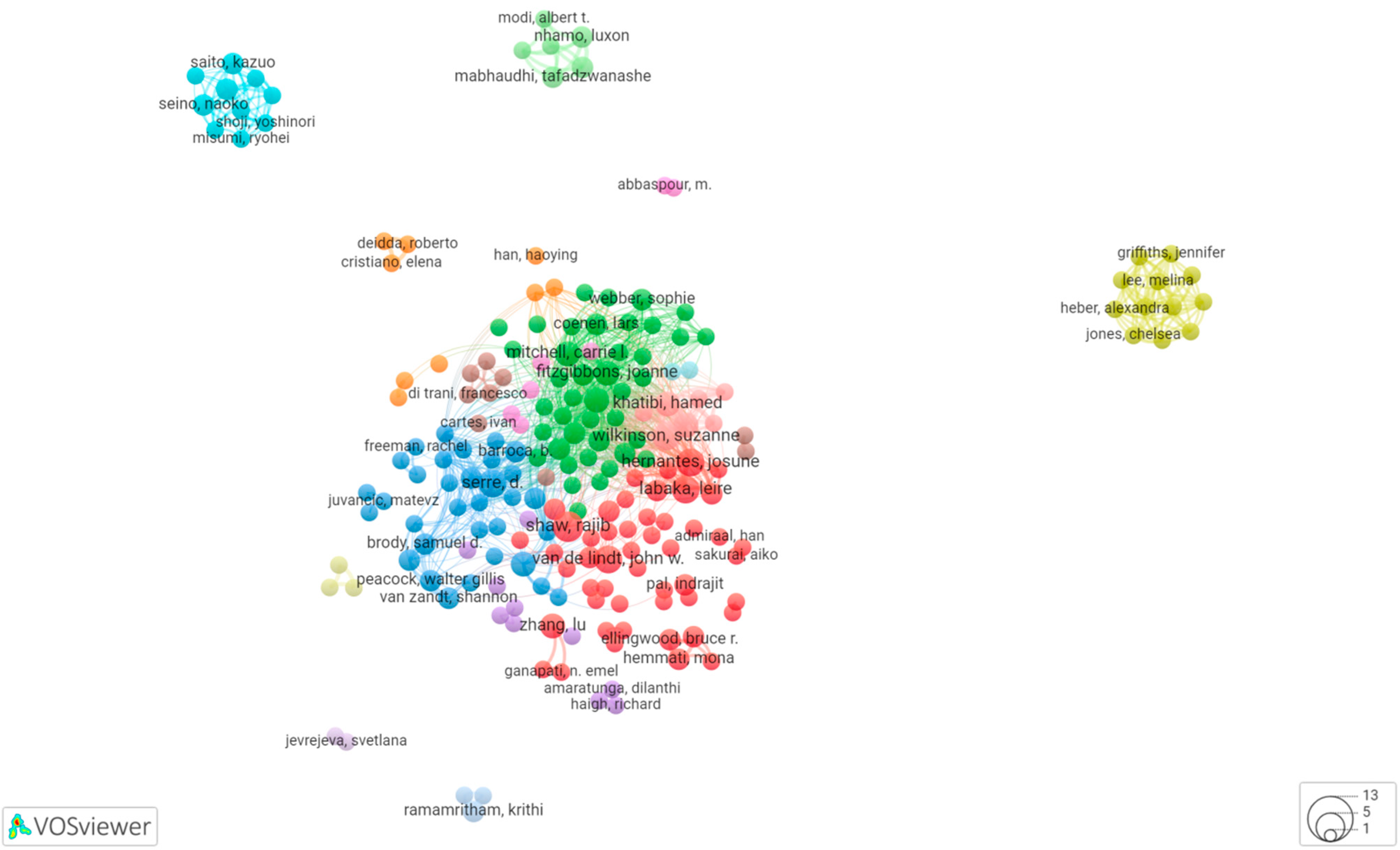

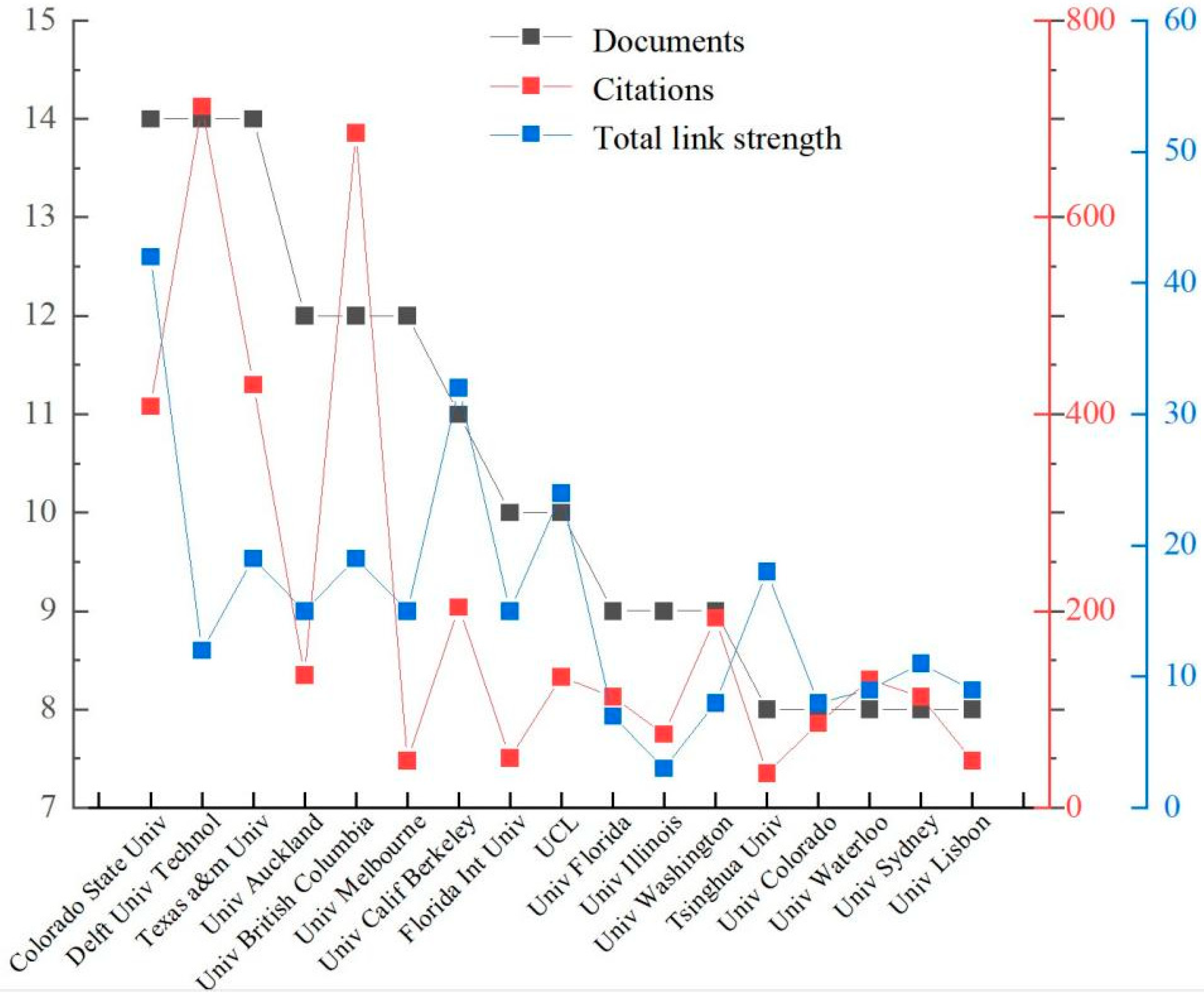

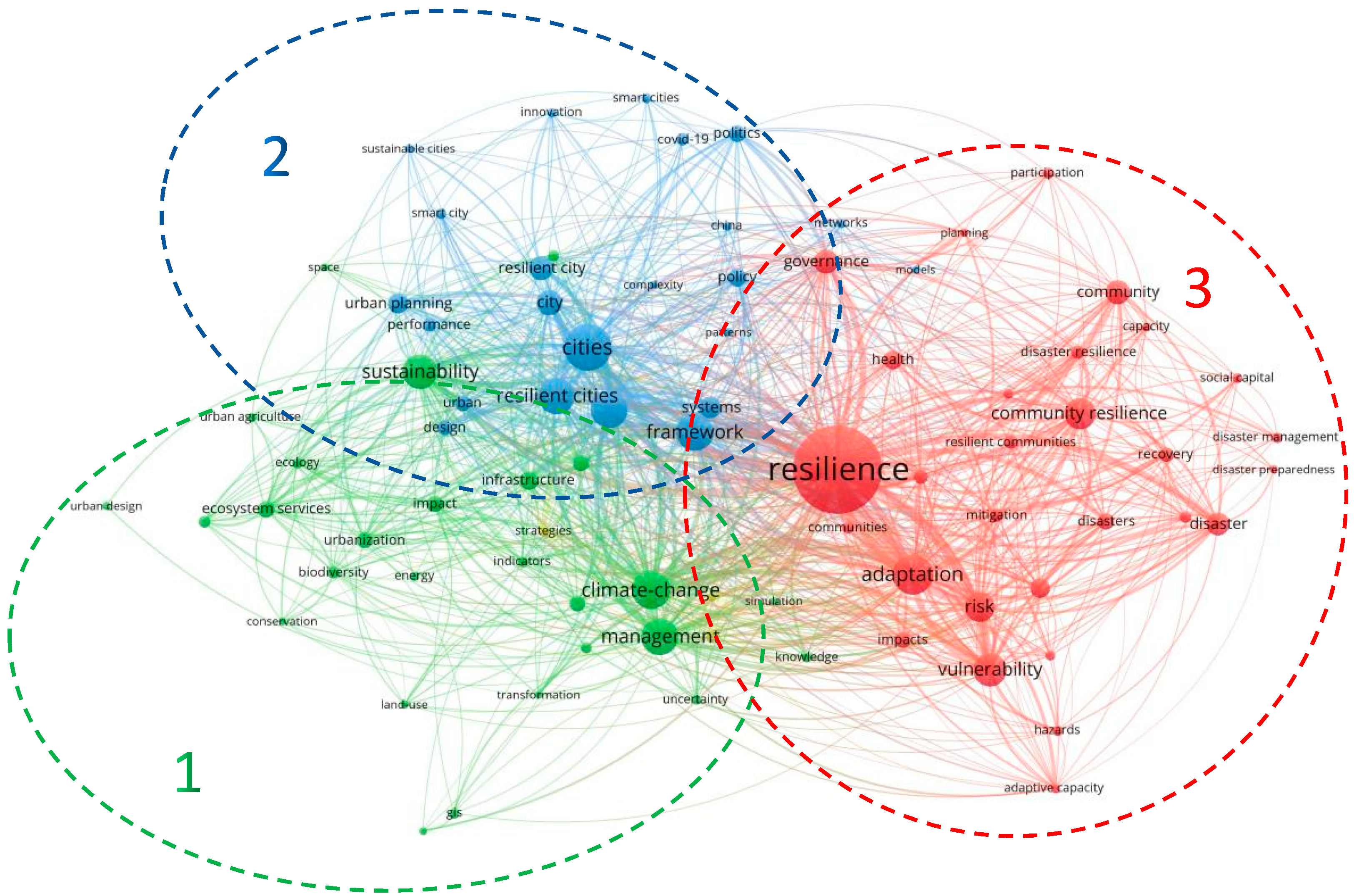
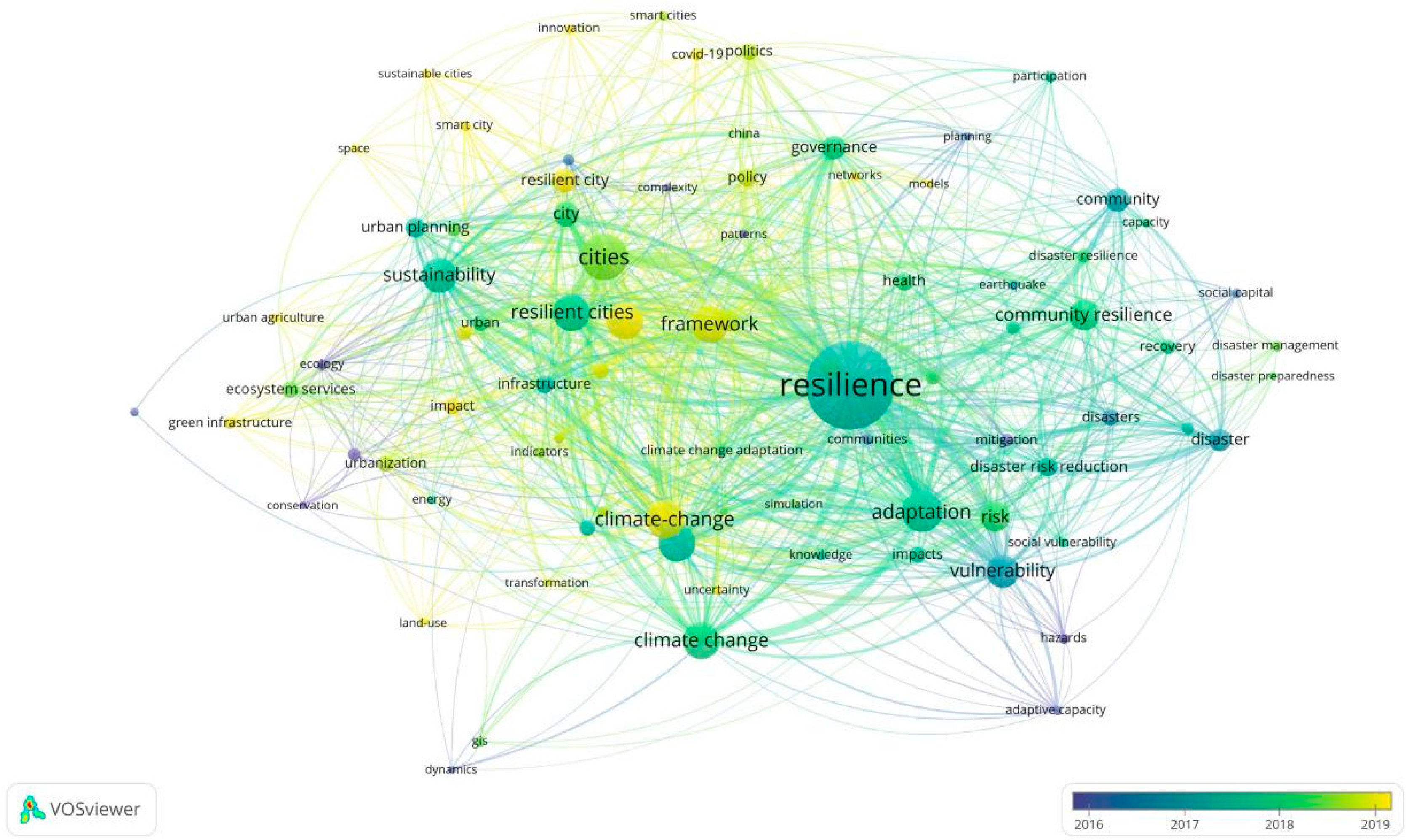
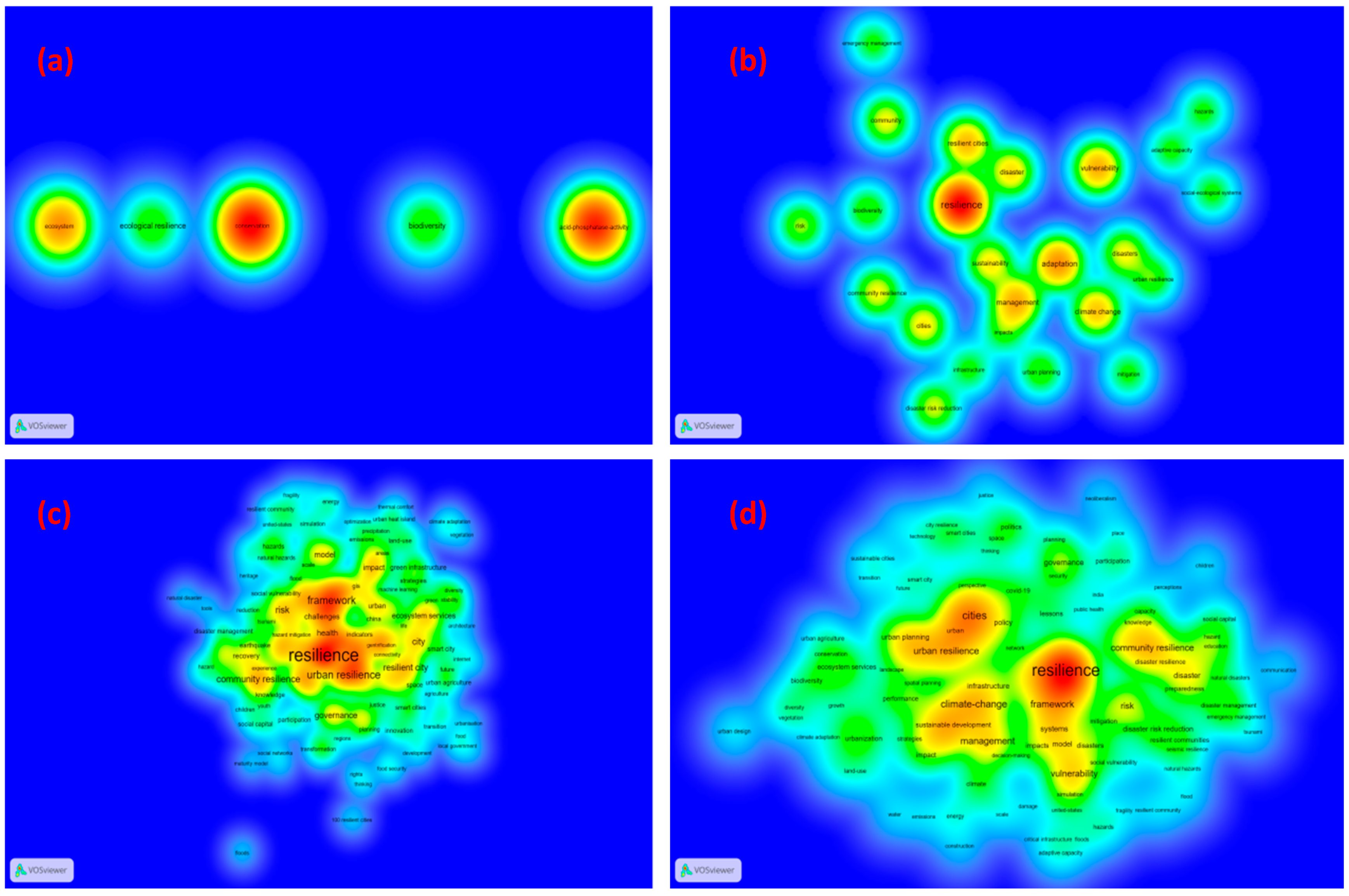
| Rank. | Type of Documents | No. of Documents | Percentage |
|---|---|---|---|
| 1 | Article | 841 | 73.2% |
| 2 | Conference record | 183 | 15.9% |
| 3 | Review | 53 | 4.6% |
| 4 | Book review | 37 | 3.2% |
| 5 | Editorial material | 35 | 3.0% |
| 6 | Publish online | 30 | 2.6% |
| 7 | Meeting abstract | 7 | 0.6% |
| 8 | Book chapter | 4 | 0.3% |
| 9 | Revise | 1 | 0.1% |
| 10 | Data paper | 1 | 0.1% |
| 11 | News item | 1 | 0.1% |
| Total | -- | 1148 | -- |
| Journal | Documents | Proportion (%) | Citations | Impact Factor in 2020 |
|---|---|---|---|---|
| Sustainability | 58 | 5.1 | 510 | 3.251 |
| International journal of disaster risk reduction | 34 | 3.0 | 448 | 4.320 |
| Cities | 29 | 2.5 | 1057 | 5.835 |
| Sustainable cities and society | 27 | 2.4 | 227 | 7.587 |
| Natural hazards | 19 | 1.7 | 485 | 3.102 |
| 7th international conference on building resilience: using scientific | 13 | 1.1 | 41 | - |
| Landscape and urban planning | 12 | 1.0 | 1532 | 6.142 |
| International journal of environmental research and public health | 11 | 0.9 | 70 | 3.390 |
| Scientia Iranica | 10 | 0.9 | 39 | 1.435 |
| Water | 10 | 0.9 | 77 | 3.103 |
| Disaster prevention and management | 9 | 0.8 | 102 | 1.521 |
| Journal of cleaner production | 9 | 0.8 | 584 | 9.297 |
| Author | Country/Institute | Documents | Average Citations Per Publication | H-Index |
|---|---|---|---|---|
| Serre, D | France/Avignon University | 6 | 26.67 | 5 |
| Shaw, R | Japan/Keio University | 6 | 12.17 | 4 |
| Berke, PR | USA/University of North Carolina | 5 | 42.2 | 3 |
| Hernantes, J | Spain/University of Navarra | 5 | 16 | 4 |
| Labaka, L | Spain/University of Navarra | 5 | 16 | 4 |
| Stults, M | USA/University of Michigan | 5 | 163.4 | 4 |
| Van De Lindt, JW | USA/Colorado State University | 5 | 9.6 | 4 |
| Wilkinson, S | New Zealand/Massey University | 5 | 4 | 3 |
| Diab, Y | France/University Gustave-Eiffel | 4 | 27.25 | 3 |
| Barroca, B | France/University Gustave-Eiffel | 4 | 17.5 | 4 |
| Rank | 1995–2004 | 2005–2014 | 2014–2022 | Global | ||||
|---|---|---|---|---|---|---|---|---|
| Terms | F | Terms | F | Terms | F | Terms | F | |
| 1 | Diversity | 2 | Resilience | 39 | Resilience | 190 | Resilience | 230 |
| 2 | Biodiversity | 2 | Adaptation | 18 | Cities | 96 | Cities | 106 |
| 3 | Ecological resilience | 2 | Vulnerability | 15 | Climate-change | 81 | Adaptation | 88 |
| 4 | Brazil | 1 | Management | 15 | Framework | 75 | Climate-change | 83 |
| 5 | Cerrado | 1 | Resilient cities | 14 | Urban resilience | 74 | Management | 80 |
| 6 | Conservation | 1 | Climate change | 13 | Adaptation | 70 | Urban resilience | 80 |
| 7 | Cultural geography | 1 | Disaster | 11 | Resilient cities | 66 | Resilient cities | 80 |
| 8 | Dynamics | 1 | Cities | 10 | Management | 65 | Framework | 79 |
| 9 | Environment | 1 | Sustainability | 10 | Climate change | 65 | Climate change | 78 |
| 10 | Fire | 1 | Community | 9 | Sustainability | 62 | Sustainability | 73 |
| 11 | Floristics | 1 | Community resilience | 9 | Community resilience | 55 | Vulnerability | 70 |
| 12 | Game gallery forest | 1 | Disasters | 9 | Vulnerability | 54 | Community resilience | 64 |
| 13 | Growth | 1 | Disaster risk reduction | 8 | Risk | 53 | Risk | 60 |
| 14 | Human ecology | 1 | Risk | 7 | City | 45 | City | 49 |
| 15 | Inequality | 1 | Urban resilience | 6 | Resilient city | 45 | Governance | 46 |
| 16 | Knowledge | 1 | Urban planning | 6 | Governance | 42 | Community | 46 |
| 17 | Mortality | 1 | Biodiversity | 6 | Systems | 40 | Resilient city | 46 |
| 18 | Permanent plots | 1 | Infrastructure | 5 | Community | 37 | Disaster | 43 |
| 19 | Recruitment | 1 | Impacts | 5 | Model | 35 | Systems | 42 |
| 20 | Resource | 1 | Social-ecological systems | 5 | Health | 33 | Urban planning | 37 |
Publisher’s Note: MDPI stays neutral with regard to jurisdictional claims in published maps and institutional affiliations. |
© 2022 by the authors. Licensee MDPI, Basel, Switzerland. This article is an open access article distributed under the terms and conditions of the Creative Commons Attribution (CC BY) license (https://creativecommons.org/licenses/by/4.0/).
Share and Cite
Huang, Y.-J.; Cheng, S.; Yang, F.-Q.; Chen, C. Analysis and Visualization of Research on Resilient Cities and Communities Based on VOSviewer. Int. J. Environ. Res. Public Health 2022, 19, 7068. https://doi.org/10.3390/ijerph19127068
Huang Y-J, Cheng S, Yang F-Q, Chen C. Analysis and Visualization of Research on Resilient Cities and Communities Based on VOSviewer. International Journal of Environmental Research and Public Health. 2022; 19(12):7068. https://doi.org/10.3390/ijerph19127068
Chicago/Turabian StyleHuang, Yu-Jie, Shuo Cheng, Fu-Qiang Yang, and Chao Chen. 2022. "Analysis and Visualization of Research on Resilient Cities and Communities Based on VOSviewer" International Journal of Environmental Research and Public Health 19, no. 12: 7068. https://doi.org/10.3390/ijerph19127068
APA StyleHuang, Y.-J., Cheng, S., Yang, F.-Q., & Chen, C. (2022). Analysis and Visualization of Research on Resilient Cities and Communities Based on VOSviewer. International Journal of Environmental Research and Public Health, 19(12), 7068. https://doi.org/10.3390/ijerph19127068








